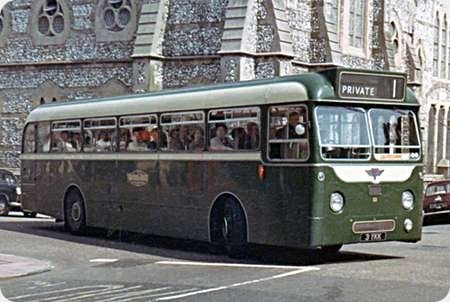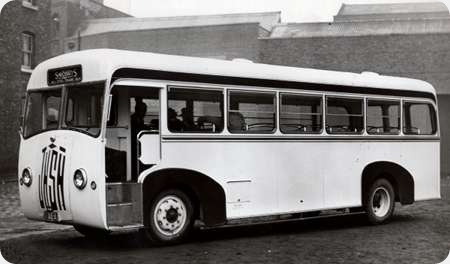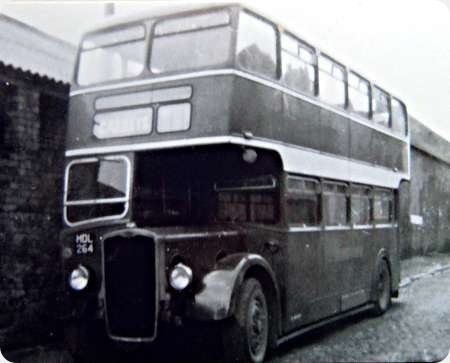Maidstone & District – AEC Reliance – 3 YKK – S 3
Maidstone & District Motor Services Ltd
1963
AEC Reliance 2U3RA
Willowbrook B53F
S 3 was among Maidstone & Districts first 36ft long vehicles being an AEC Reliance 2U3RA with a Willowbrook B53F body delivered in September 1963 as part of a batch of four, the body was to the early BET design with a curved rear dome and the four piece flat glass windscreen. The style of which was later fitted with first the curved windscreen and later still the peaked rear dome, overall I did like the BET design. The distinctive Maidstone & District livery always looked good on any type of body, with it’s cream ‘moustache’ below the windscreen and cream bands below and above the side windows, that above the windows having a subtle light green edging which combined with the dark green main colour looked pure class. This was one of very many fine liveries lost to NBC’s corporate dead hand (and head) now only seen at rallies etc. Todays colour schemes, I refuse to call them liveries, nearly all scream TAT, never CLASS, there that is my rant for today!!
Photograph and Copy contributed by Diesel Dave
24/08/15 – 06:04
I agree entirely Dave about modern colour schemes. I’ve just been to Blackpool for the first time in many years and the once smart fleets of cream and green buses and trams have been replaced by a mish-mash of black and yellow on the buses and purple and white on the new trams. To compound the felony most of the vehicles in both fleets are festooned in hideous adverts all over the vehicles including the windows. There were two of the Balloon trams running on the day of my visit on Heritage Tours in the original liveries and again compared to the modern stuff they looked sheer class.
Philip Halstead
25/08/15 – 06:19
PMT had two similar batches of buses, ten like this on AEC Reliance chassis, the other ten on early Leyland Leopards. They squeezed in 54 seats (I seem to remember an inward facing single behind the entrance door). Thinking back, they must have been a bit cramped for leg room or maybe people were smaller generally in those days. I agree entirely that the later BET design with curved front and rear windows was a true classic – even this version had a touch of class about it.
Ian Wild
26/08/15 – 05:50
NGT’s Percy Main depot ‘Tynemouth & District’ had two 49 seat D/P versions from 1962, FFT 812/3 – 262/3. They were on a Leyland Leopard PSU3/3R chassis. On Saturdays during the summer months, drivers on 0800 spare would often find themselves doubled up with a Northern driver doing a Dup to Blackpool. The bodies were stylish and well built, and the Leyland wasn’t a bad vehicle, however, I always found them to be a bit on the clumsy side, perhaps it was the low sitting position, or the lack of power steering.
Ronnie Hoye
26/08/15 – 05:50
One of these days someone with clout within the hierarchy of a significant operator, is going to (1) tell the PR/Marketing gurus to go and play with an alligator, (2) bring back a modest dignified livery, not invented by "Toys R We", and (3) restore windows (and former window apertures), to the purpose for which they were invented – looking through! He (or she) might even throw out stupid punning route descriptions, and substitute a series of proper route numbers that starts at 1 and carries on until all the routes have been covered – usually without getting anywhere near the 3-digit variety, let alone the 500, 600, 700 etc. series.
Stephen Ford
26/08/15 – 17:24
And so say all of us, Stephen.
David Wragg
26/08/15 – 17:24
Absolutely spot on, Stephen, and magnificently put.
Steve Crompton
27/08/15 – 06:36
I fully understand what Stephen F means. But let’s not forget that traditional London Transport used route numbers up to the 700s well before this site’s 1970 date. It seems that 1-199 were red bus routes, 200-299 were single-deck routes, 300-499 were green bus routes, 500-699 were trolleybus routes, and 700-799 were Green Line routes. At the trolleybus conversions, though, some were renumbered into the 200 series. Southdown also had an "area scheme" for their route numberings, such as the 40’s in the Portsmouth area, and the 50’s in Chichester and Bognor. If these overran, the equivalent 100 series were used. But there were no 200’s until after NBC took a hand, and 700’s were used for Limited Stop services. I remember BMMO and Crosville had letter prefixes to some services for local areas. So although there may be a case for using low numbers for bus routes, not all traditional bus companies followed that philosophy forty or fifty years ago!
Michael Hampton
27/08/15 – 10:45
Portsmouth Corporation befuddled many a holidayer by giving some routes a different route number for each direction – 18 one way and 19 on the return, for example. But, later, it stopped doing this, leaving two systems in place. As for route suffixes, it used them for the same route, but shortened sections. The highest I recall was the 143 which went up to 143F! Stagecoach West, my local operator, however, uses them for deviations on a basic route.
Chris Hebbron
27/08/15 – 17:06
Quite right Michael and Chris. Obviously big operators will in any case need to go into the hundreds. Midland Red was an obvious example (Lichfield-Stafford route 825 etc), and so were Western/Southern National. In my own local area the much-lamented Midland General used a letter followed by single digit number, which would in theory have given them up to 234 two-digit route descriptions – though, in fact, they never got beyond letter G! It seems strange that in the deregulated/privatised bus scene route numbers can be dictated by the dead hand of local government, because the public are not credited with enough intelligence to distinguish between a red number 25 and a blue number 25. Of course, it would help if all the buses operated by a particular operator were painted blue, or red, or whatever instead of random daubings of ginger-pink with yellow stripes (which is where I came in!…)
Stephen Ford
27/08/15 – 17:07
With the creation of T&W PTE, control of all services wholly, or where the majority of the route was within the boundaries of Tyne and Wear passed to the PTE. These services were operated by the former Corporation fleets of Newcastle, South Shields and Sunderland, as well as NGT group companies and United, and several independents who ran unnumbered routes. Having gained control, the PTE in their wisdom or otherwise decided that no two routes within their area would have the same number, and regrdless of company, all vehicles on those routes would share a common livery. Former Newcastle routes remained more or less unaltered, numbers where then anything from 100 to 800 groupings, depending on the area. I suppose it made sense to someone, but the public didn’t like it at all, especially in areas which had previously been served by several different companies, all of whom had a different livery.
Ronnie Hoye
27/08/15 – 17:08
Just a small point. The route pairings on Portsmouth Corporation were different. 18/19 was not a route pair although 17/18 and 19/20 were. (Personally I always found this system more convenient than the the usual bi-directional system.)
Incidentally, route numbers such as 143 covered journeys outside the city boundary and were from the Southdown series. Thankfully, there are now many books available covering the Portsmouth Corporation system for those looking for further information.
Andy Hemming
28/08/15 – 06:52
I should have known better than to mix up two trolleybus routes on which travelled frequently, Andy. Thanks for correcting me.
I should also have mentioned, originally, that the corporation’s ‘local’ bus routes were lettered, too. The 1xx series, logically, covered areas some miles outside Portsmouth (Leigh Park, for example) and into Soouthdown territory, to which their buses could go, as they were building developments created especially for ex-Portsmouth residents displaced by wartime bombing.
Chris Hebbron
28/08/15 – 06:54
Philip, I have just been to Blackpool and I noticed some slightly smarter newer buses which are Grey with Lemon though of course their dark tinted windows tend to look blackish, much nicer than the Black and Yellow, but horror of horrors they have some of the heritage trams in that Purple, I hadn’t noticed them on previous visits. Bolton 66 was out and running on the limited stop heritage rides today.
John Lomas
28/08/15 – 06:54
The difference between a red 25 and a blue 25? Well, In the 1950’s/60’s, Southdown managed to run two routes designated 38! Fortunately they were about 50 miles apart, as one was in Brighton, the other in Portsmouth, so never the twain met. I haven’t checked this, but I think the Brighton one was eventually run by BH&D after the BATS scheme came into operation. Did any other of the larger companies have a pair of routes within their territory with the same number, but separated by a fair distance?
Michael Hampton
29/08/15 – 06:51
Manchester, up until the end of the trams, had trams, trolleybuses and buses, all with the same route number running through the city centre, all serving different destinations.
Phil Blinkhorn
01/09/15 – 07:37
You also had the phenomenon of a joint service on which each operator used a different number, e.g. Huddersfield – Bradford, where for a number of years Hebble used 12, Huddersfield JOC 38 and Bradford 64, or Gloucester – Hereford, where Bristol used 55 and Red & White 38.
Geoff Kerr
29/09/18 – 06:57
Southdown also had two routes numbered 15 when it became involved in Brighton area Transport services. It took over the Brighton service 15 from Brighton Hove and District when it was co-ordinated with the 13 route (which was already worked by Southdown). The other Southdown service 15 was Eastbourne – Hastings via Polegate, worked jointly with Maidstone & District Motor Services.
Andrew Newland
Quick links to the - Comments Page - Contact Page - Home Page



